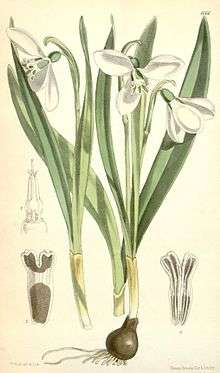Galanthus elwesii
Galanthus elwesii (Elwes's snowdrop, greater snowdrop) is one of a number of species of the genus Galanthus, herbaceous, perennial, bulbous plants belonging to the family Amaryllidaceae. It is a native of the Caucasus.
| Galanthus elwesii | |
|---|---|
 | |
| Galanthus elwesii | |
| Scientific classification | |
| Kingdom: | Plantae |
| Clade: | Tracheophytes |
| Clade: | Angiosperms |
| Clade: | Monocots |
| Order: | Asparagales |
| Family: | Amaryllidaceae |
| Subfamily: | Amaryllidoideae |
| Genus: | Galanthus |
| Species: | G. elwesii |
| Binomial name | |
| Galanthus elwesii | |
| Synonyms[1][2] | |
|
Synonyms
| |

This herbaceous perennial plant grows to about 20–25 cm high. It grows from a globose bulb, 2–3 cm in diameter. It produces two leaves which are obtuse, linear, and blue-green in colour. The flowers are globose, white, pendulous, and 2–3 cm long, and solitary at the tip of a solid, pointed scape. The outer floral tepals are oblanceolate, with shorter inner tepals that are emarginate (notched at the apex) and taper towards their base with green patches apically and basally (see illustrations). The fruit forms a dehiscent capsule that forms three valves. Overall G. elwesii is a more robust plant than G. nivalis.[3][4][5][6]
Taxonomy
G. elwesii was identified by the British botanist Henry John Elwes on a visit to Turkey in 1874. In early April, whilst in the mountains near Smyrna (modern Izmir), he came across "the fine large snowdrop which now bears my name". It was then formally described by Joseph Dalton Hooker (1875) and named G. elwesii, with an illustration by W H Fitch in Curtis's Botanical Magazine, and thus the species bears his name as the botanical authority.[3][7] Later the plants collected by Elwes were found to actually be G. gracilis but the name was retained for a different specimen.[8][9]
Etymology
The species is named in honour of Henry John Elwes.
Distribution
A native of the Caucasus, the species has been widely introduced.
Cultivation
G. elwesii is grown as an ornamental plant in gardens where they easily naturalise. Bulbs planted in the autumn flower in the early spring. Propagation is by separation of bulbils after flowering.[4][5]
References
Bibliography
- Davis, Aaron (1999). The genus Galanthus. A Botanical Magazine monograph. Portland, Oregon: Timber Press. ISBN 0-88192-431-8.CS1 maint: ref=harv (link)
- Harvey, M.J. (21 May 2000). "Davis: The genus Galanthus" (Book Review). Botanical Electronic News (250).CS1 maint: ref=harv (link)
- Dimitri, M (1987). Enciclopedia Argentina de Agricultura y Jardinería. Tomo I. Descripción de plantas cultivadas. Buenos Aires: Editorial ACME S.A.C.I.CS1 maint: ref=harv (link) see Enciclopedia Argentina de Agricultura y Jardinería
- Harland, Gail (2016). Snowdrop. London: Reaktion Books. ISBN 9781780236285.CS1 maint: ref=harv (link)
- Hessayon, D.G. (1995). The bulb expert (2003 ed.). London: Sterling Publishing Company (Expert Books). ISBN 9780903505420.CS1 maint: ref=harv (link)
- Hooker, Joseph Dalton (1875). "Galanthus elwesii". Curtis's Botanical Magazine. 31: 6166.CS1 maint: ref=harv (link)
- Yüzbaşıoğlu, Sırrı (2012). "Morphological variations of Galanthus elwesii in Turkey and difficulties on identification" (PDF). Bocconea. 24: 335–339.
- "The Plant List: a working list of all known plant species. Version: 1.1". Royal Botanic Gardens, Kew and Missouri Botanical Garden. September 2013.
- MBG. "Missouri Botanical Garden". Retrieved 7 October 2016.
- "Tropicos". Missouri Botanical Garden. 2015. Retrieved 30 December 2015.
- "World Checklist of Selected Plant Families". The Board of Trustees of the Royal Botanic Gardens, Kew. Retrieved 6 October 2016.
- RHS (2016). "Galanthus elwesii: Elwes's snowdrop". Royal Horticultural Society. Retrieved 9 October 2016.
External links
| Wikimedia Commons has media related to Galanthus elwesii. |
| Wikispecies has information related to Galanthus elwesii |